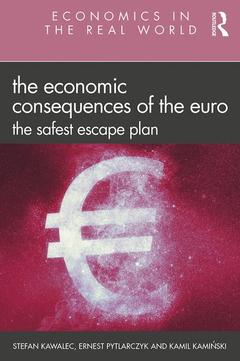The Economic Consequences of the Euro The Safest Escape Plan Economics in the Real World Series
Auteurs : Kawalec Stefan, Pytlarczyk Ernest, Kamiński Kamil

This book presents a new narrative on the eurozone crisis. It argues that the common currency has the potential to kill the European Union, and the conventional wisdom that the eurozone can be fixed by a common budget and further political integration is incorrect.
The authors address key questions such as why the European Union and the single market have been successful, why the common currency poses a threat to European integration, and whether it is possible to either fix the eurozone or dissolve it while keeping the EU and the single market. Contrary to the view that it would be best if the Southern European countries left the eurozone first, the book makes the case that the optimal solution would be to start the process with the most competitive countries exiting first. The authors argue that a return to national currencies would be beneficial not only to the crisis-ridden southern countries, but also to France and Germany, which were the main promoters of the single currency. An organised unwinding of the euro area would be beneficial both for the European economy and for Europe?s main trading partners.
The authors contend that to defend the euro at all costs weakens the European economy and threatens the cohesion of the European Union. If pro-European and pro-market EU leaders do not dismantle the eurozone, it will most likely be done by their anti-European and anti-market successors. If that happens, the European Union and the common market will be destroyed.
This book will be a useful and engaging contribution to the existing literature in the fields of macro, monetary and international finance and economics.
List of illustrations. List of contributors. Acknowledgements.
Introduction and overview. Part I: From the success of the European Union and the single market to the euro crisis. 1. The European Union and the single market: Europe’s great success 2. The euro as an intended step towards strengthening the EU and the single market 3. The eurozone at a crossroads
Part II: The significance of national currencies and exchange rate adjustments. 4. Loss of international competitiveness and inability to restore it as a source of the problems of the eurozone’s depressed economies 5. International competitiveness should not be confused with productivity 6. Currency weakening compared to deflationary policy: Two alternative scenarios for restoring international competitiveness 7. The meaning of exchange rate adjustments (bike trip example) 8. The tragic experience of the defence of the gold standard through deflationary policy during the Great Depression 9. Devaluations that allowed countries to escape from crises in the post-war period 10. The cases often presented as the evidence of effectiveness of the internal devaluation 11. Controversies surrounding devaluation
Part III: Can Europe compensate for the lack of national currencies? 12. The search for solutions that will repair and strengthen the eurozone 13. Can fiscal union deliver the tools to improve threatened countries’ competitiveness? 14. What could a more flexible labour market deliver? 15. Can a fiscal union protect eurozone members from future problems with competitiveness? 16. The US, nation states and underdeveloped regions, and the ability of a single currency to function in Europe 17. The optimum community level for a single currency
Part IV: What are the consequences of defending the Euro at all costs? 18. The threat to European integration 19. Conflicts with trading partners
Part V: How to return to national currencies, while preserving the European Union and single market? 20. The euro trap 21. The way out of the euro trap: Germany should leave first 22. The main elements of the strategy for a coordinated euro break-up 23. Impact of the proposed strategy on risks associated with segmentation of the eurozone 24. The special role of the ECB during the transition period 25. The ability to cope with banking and debt crises 26. A new currency coordination system in Europe 27. Europe avoids conflicts with trading partners; Germany avoids a hard landing 28. Who can initiate the dissolution of the eurozone? 29. A new Bretton Woods. Conclusion.
The European Solidarity Manifesto. Bibliography. Names Index. Geographical Names Index.
Stefan Kawalec is the CEO of Capital Strategy, a strategy consulting company in Poland, and a co-founder of the European Solidarity Manifesto.
Ernest Pytlarczyk isthe chief economist at mBank S.A., one of the biggest commercial banks in Poland and a subsidiary of Germany’s Commerzbank.
Kamil Kamiński is an advisor to the CEO of PKO Bank Polski S.A., Poland’s biggest commercial bank.
Date de parution : 12-2019
15.6x23.4 cm
Date de parution : 12-2019
15.6x23.4 cm
Disponible chez l'éditeur (délai d'approvisionnement : 14 jours).
Prix indicatif 160,25 €
Ajouter au panierThèmes de The Economic Consequences of the Euro :
Mots-clés :
Southern Eurozone Countries; A New Bretton Woods; ECB; Saving the Eurozone and common market; IMF; New European grand strategy; International Monetary Fund; Global Imbalances; Balanced Current Account; Banking sector systemic risk; Keynes; Controlled dismantling of the Euro zone; Wo; Eurozone at a crossroads; Unlimited; Post-war; currency; EUR; International Competitiveness; Currency Coordination System; saving the Eurozone; Eurozone Country; saving the common market; Internal Devaluation; Fiscal Union; Eurozone crisis; Real Gdp; Euro crisis; European Central Bank; Euro; Gdp Growth; Euro area; Hartz Reforms; EU Member State; European Union; Deflationary Policy; European integration; Currency Coordination; European economy; Competitive Countries; Current Account Surpluses; Fiscal Transfers



